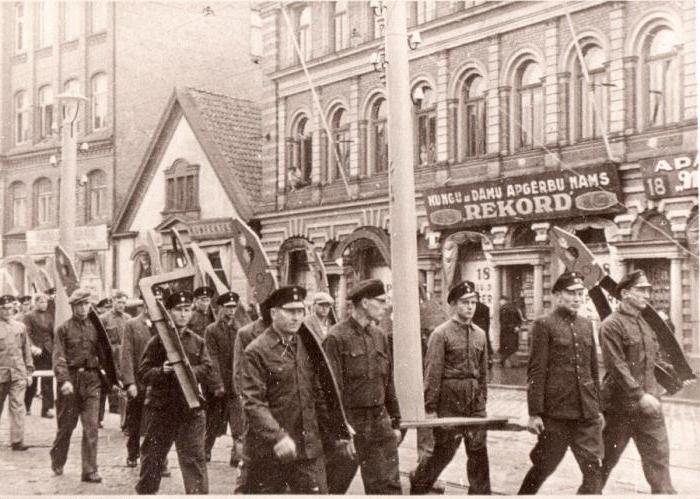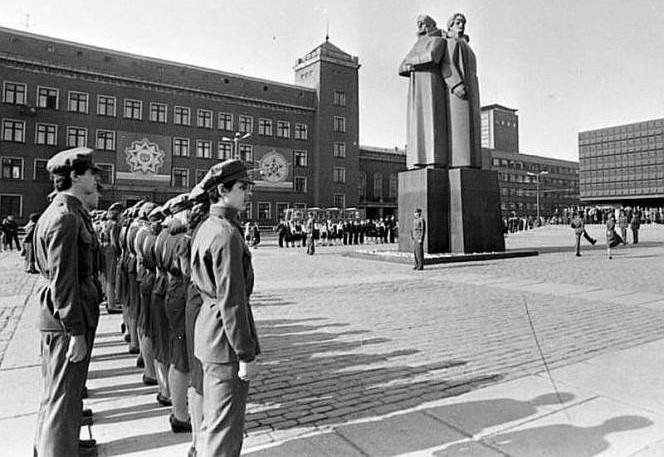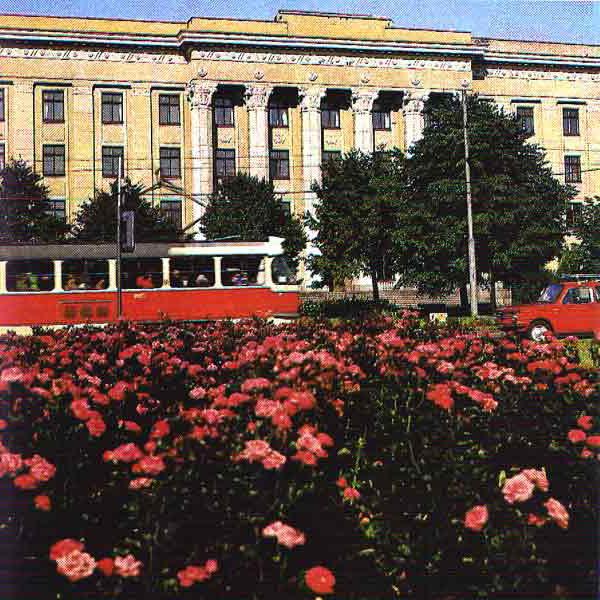In the year 91, the USSR ceased to exist. However, earlier the Baltic republics, including the Latvian SSR, separated from it. Despite various interpretations of the history of its formation and existence within the framework of the Soviet Union, one cannot but recognize the achievements of that period. And they were, and considerable!
Background
On the acceptance of another republic by the USSR, the inhabitants of the Soviet Union learned on August 5, 1940. However, the background to this event began back in 1939 with the signing of a pact between the USSR and Germany, to which secret protocols were attached, which clearly delineated the areas of their interests in Eastern Europe. In particular, Latvia, Estonia, Finland should have been controlled by the Soviet Union, and Lithuania - controlled by Germany. As for Poland, its eastern regions were recognized as the sphere of interests of the USSR, and the western regions as the Third Reich.

After the outbreak of World War II, the Baltic countries declared their neutrality. However, after the occupation of Poland, they were forced to agree to the entry of Soviet troops. As a result, from the end of October, parts of the 16th Rifle Corps, as well as the 31st High Speed Bomber and 10th Fighter Aviation Regiments and other units with a total number of 25,000 people, were stationed in Lithuania.
The entry of Soviet troops
In mid-June 1940, the Soviet government presented ultimatums to Lithuania, Latvia and Estonia, in which their state leaders were accused of violating the terms of the mutual assistance agreements previously concluded with the USSR. In addition, these countries were required to deploy additional contingents of Soviet troops on their territory and form new ones. Terms have been accepted. A day later, units of the Red Army entered Latvia. A new government was also formed, headed by A. Kirchenstein. It organized the elections to the People’s Diet. They won the only allowed political force called "Bloc of the working people."
Education of the Latvian SSR
At the first meeting of the People’s Diet, Soviet power and the formation of the Latvian SSR were proclaimed. In addition, the deputies sent an official request to Moscow to accept the republic into the USSR. She was satisfied, and on August 5, Latvia became part of the Soviet Union. Immediately, work began to amend the Constitution and the formation of new local authorities.
History of the Latvian SSR (pre-war period)
The first steps of the new government caused various responses from the residents of the republic. For example, immediately after the deputies proclaimed the formation of the Latvian SSR (year - 1940), the debts of the peasant farms began to be written off, which the majority of rural residents enthusiastically accepted. At the same time, nationalization was carried out, including of large residential buildings, which generated discontent among urban residents belonging to the middle class.

In addition, the joint use of rubles and lats led to a shortage of goods and an increase in prices, due to which it was decided to withdraw the national currency from circulation. At the same time, those who had deposits with banks suffered large losses, since amounts over 1000 rubles were confiscated. The formation of state farms also caused a storm of indignation, where members of small peasant farms were forcibly recorded. As a result, by the beginning of the German invasion of the USSR, the republic had a rather tense political situation, several clandestine anti-Soviet organizations were operating. The time has come for punitive measures - the shooting and sending to the camps of the Latvian military, as well as the deportation of more than 14,000 civilians suspected of supporting the resistance forces.
An occupation
The Latvian SSR was one of the first to be targeted by the Wehrmacht army. However, while in Belarus and Ukraine the population supported the Red Army, in Latvia the situation developed in a completely different scenario. So, immediately after the intensive bombing of Ventspils and Liepaja, an uprising against the Soviet regime began in the country. Members of the underground organizations formed, from those who were dissatisfied with the policies of the new authorities, self-defense units and began to attack units of the Red Army. According to estimates made already in the post-war years, only in June they killed 6,000 Communists, Soviet officials and Jews.
In order to save those civilians who were threatened by the reprisal of the nationalists, the Soviet government evacuated them inland. In total, more than 53,000 people who previously lived in the Latvian SSR were taken out.
As part of the Reich Commissariat Ostland
On July 1, the Wehrmacht troops entered Riga, where they were greeted with enthusiasm and transferred 1,500 captured Soviet soldiers. At the same time, members of the "self-defense units" burned the Riga Choral Synagogue together with 600 Jews driven there and shot more than a thousand representatives of this people in Daugavpils. By July 4, the Latvian SSR completely came under the control of the German army, and its government was evacuated to Moscow.
On September 1, 1941, the republic became part of the Ostland Reich Commissariat. It was prescribed to be called the general district. However, after a year and a half, the Germans ceased to be perceived as liberators, since life did not become easier. Nevertheless, there were people who agreed to join the Latvian SS Legion. According to contemporaries, most of his soldiers were patriots who wanted to see their country independent. They chose Germany, because they saw in it a lesser evil and hated Russia.
After the war
Thanks to the heroism of the Soviet people, the Nazis failed to bring the USSR to their knees. On October 13, 1944, Soviet troops entered Riga. Immediately after that, the Latvian SSR began to restore its central authorities, industry and agriculture.
At the same time, the flywheel of the Soviet repressive machine was turned on at full power, which led to the deportation of 40,000 people. In order to provide food for the regions of the USSR, which suffered more than Latvia during the war, conducted violent collectivization.
Industry development
Since the republic suffered less during the war years than other occupied regions of the USSR, its restoration was proceeding more rapidly. Within a few years, the population felt positive changes in a number of areas. In particular, from the beginning of the 50s the industry of the Latvian SSR began to develop. Such giants as RVZ, RAF, VEF, “Switch”, “Alpha”, REZ, Popov Radio Plant, as well as Riga and Plyavinskaya HPPs and several thermal power plants were commissioned. Housing construction was actively conducted.
The achievements of Latvia during the Soviet period include the creation of a developed road network, the modernization of agriculture, as well as positive developments in secondary and higher education, sports, culture and healthcare.
New cities
Industrial development was one of the main achievements that the Latvian SSR was proud of. The cities of the republic grew due to the influx of labor necessary for the functioning of large enterprises. In addition, some villages changed their status. So, the cities of Olaine and Viljaka and a number of other small settlements became.
Tourism
Although resort villages were located on the coast of the Gulf of Riga before the war, only in the 1950s did an extensive network of sanatoriums and rest houses form in the republic. In particular, the city of Jurmala, which was formed in 1959, has become one of the most prestigious resorts in the USSR. The mild climate, clear sea, gorgeous beaches, beautiful nature and healthy air made the Latvian stretch of the Baltic Sea coast a desirable place for spending summer vacations, especially since many residents of the Soviet Union viewed the Baltic as to some extent “abroad”.
Tourists from all over the vast country were attracted by the sights of the Latvian SSR. For example, many guests from other republics were delighted with ancient monuments of history and architecture of Riga, such as the Dome Cathedral, St. Peter's Church, the House of the Blackheads , etc. They could see many interesting sights outside the Latvian capital. Particularly popular were excursions involving visits to the Mezotnensky and Rundalsky palaces, the Turaida castle, the Old Town Hall and the Church of the Holy Spirit in Bauska.
In addition, the sights of Latvia created during the Soviet period were of interest. Among them, the Riga TV Tower, Salaspils Memorial Complex for the Victims of Fascism and more.
Demographic situation
The natural and mechanical movement of the population of the Latvian SSR in different periods of its history was very different. Among the main reasons can be noted:
- exile to remote regions of the USSR of persons recognized disloyal to the Soviet regime;
- casualties among civilians of men drafted into the Red Army and joining the Wehrmacht units during the war years;
- traditionally low birth rates, which have fallen further due to urbanization;
- solving the problem of labor shortages by resettling citizens from other republics to the Latvian SSR;
- high standard of living, attracting migrants and more.
As a result, the number of non-indigenous representatives living in the territory of the Latvian SSR has sharply increased. After independence, it was found that about a third of the country's inhabitants are people who moved from other union republics in 1940-1989 and their children. In the wake of the rise of ultrapatriotism, this category of the population was called non-citizens and discriminated against. Later, their rights were somewhat expanded, however, to this day they do not participate in elections, cannot occupy a number of posts and work in some areas. This seems like absolute nonsense, especially since the country is a member of the EU, where absolute tolerance is proclaimed even against illegal migrants.

Now you know how and why the formation of the Latvian SSR occurred (date - July 21, 1940). Like many other historical events, it had both positive and negative aspects. It is hoped that Latvia will be able to overcome all the problems it faces (lack of investment, the outflow of the able-bodied population, a large income gap between the rich and poor, etc.) and will not continue to blame them on the “Soviet past”, trying to obliterate all the good, what happened in the years 1940-1990.